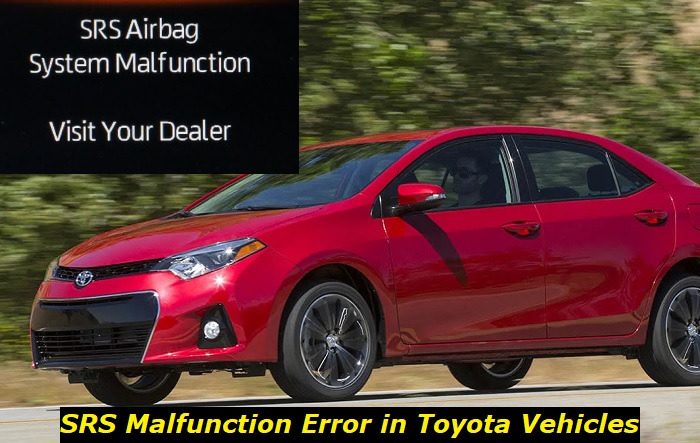Driving a car carries a certain degree of risk, which is why safety features like airbags are built into them. These safety features increase the chance of survival during accidents, so it is important to make sure these safety systems are always fully operational. This is why modern vehicles come with warnings that inform you when problems are discovered in your car's safety features. One such warning is the "SRS Airbag System Malfunction". Why does this warning come up?
SRS airbag system malfunction message highlights
- Common reasons:wiring issues, wireless charger problems
- How to fix:take it in for inspection
- Possible consequences:safety system may not be working
- Priority level:High
- Can you drive?Carefully
- DIY repair:Impossible
- Repair price range:$200-$400

What Does SRS Airbag Malfunction Mean?
The SRS airbag warning informs you of a potential problem with your airbag. It means that your car has detected an issue that might prevent one or more of the airbags from deploying during a collision.
The SRS in your car is the Supplemental Restraint System. This is the system that keeps you safe in the event of an emergency. It protects you from impact and supplements the function of the seatbelts to make sure that you aren't thrown from the vehicle during serious collisions.
Your airbags are part of this system. Using a collision sensor, the airbags rapidly fill with gas when a collision is detected. Once an occupant makes contact with the airbag, it starts to deflate, cushioning vehicle occupants in an accident.
What Causes an Airbag Malfunction?
The airbag system relies on many different parts and systems working together to detect and respond to collisions. A problem in any of these parts can result in issues that could prevent the airbag from deploying, causing the "SRS airbag malfunction" warning to appear.
1) Improperly Installed Steering Wheel
One of the airbags is located inside the steering wheel. This airbag protects the driver during accidents. Work on the steering wheel or steering column could inadvertently affect the operation of the steering wheel airbag.
If the steering wheel has recently been replaced, then it is possible that an improper installation has caused the new airbag to malfunction.
This will require the steering wheel to be inspected and correctly reinstalled by a professional mechanic.
2) Passenger Seat Occupancy Sensor Malfunction
This is a sensor in the front seat that detects weight in the front seat. This lets the system determine if someone is sitting in the passenger seat so the airbag can be deployed during an accident.
If the sensor is faulty, the SRS won't be able to determine if an occupant is present in the passenger seat. This can prevent the system from protecting a passenger during an accident.
If the passenger seat occupancy sensor is malfunctioning, it will need to be removed and replaced. This requires the passenger seat to be removed to access the sensor. If you have sufficient experience, you can remove and replace the sensor yourself.
3) Defective SRS Module
The SRS module is a computer that acts as the brain of the SRS system. It uses input from the sensors to determine when the car is in a collision, and which airbags to deploy. The system also runs diagnostic checks on the airbags to determine potential malfunctions.
This module is like any other electronic system and can break down as a result of heat, age, or water damage.
A defective SRS module will need to be replaced. The most effective way to do this is simply to get the replacement done at a Toyota dealership.
4) Faulty Airbag Sensors
The airbags are deployed when the SRS determines that the car has been in an accident. It does this using the input of many different sensors. If any of these sensors malfunction, the SRS won't be able to accurately determine when a vehicle has occurred, which could lead to an airbag deploying at the wrong time, or not at all.
An experienced mechanic will be able to diagnose your car to determine which sensors need to be replaced. They will then be able to install the appropriate replacement sensor for you and ensure that your airbag system is working effectively.
5) Broken Clock Spring
The clock spring in the driver's airbag keeps the airbag electrically connected to the airbag. It winds and unwinds as the steering turns to maintain the electrical connection. This constant movement can cause it to wear down and break, disconnecting the steering wheel airbag from the SRS.
The clock spring is important to the function of the steering wheel. A broken clock spring can result in a clicking noise when turning the wheel. It can also cause stiffness in the steering wheel, which reduces the vehicle's responsiveness and makes it less safe to drive.
Faulty steering wheel buttons and a malfunctioning horn are other signs that your steering wheel clock spring needs repair.
Repairing a broken clock spring is possible. However, if the level of damage to the clock spring is severe, it will need to be replaced entirely.
If your car shows signs of a damaged clock spring, you should take the car to a mechanic to have it repaired or replaced as soon as possible.
6) Depleted Battery
The airbag sensors are powered by the car's battery. These sensors require a certain voltage to work effectively. If they don't receive the required voltage, they may malfunction or struggle to turn on. This results in the car detecting an issue with the SRS and displaying the SRS malfunction warning.
While airbags are designed to deploy at low voltages, a weak battery can still result in some issues with the airbags deploying effectively and dependably.
If the battery is simply weak, you can attempt to recharge it by allowing your engine to run for 25-30 minutes. This gives the alternator a chance to charge the battery sufficiently.
If charging the battery doesn't work, then the battery might be old or defective and no longer able to hold a charge. If this is the case, you should replace the old battery with a new one.
What To Do About an Airbag Malfunction?
When your car notifies you about an airbag malfunction, it should be treated as an urgent matter. Driving around with uncertain airbags is not recommended, for your safety and the safety of your passengers.
Dealing with faulty airbags isn't an easy task, as the airbags are complicated systems. Not only are they complicated, but they can also be dangerous to work on, as a mistake while working on them can result in the airbag suddenly deploying. This could cause injury from the airbag's expansion, or from the force of the expansion launching any tools you're working with.
You should take your car to a trusted professional mechanic or a Toyota dealership where the issue can be diagnosed and repaired for you.
Is It Safe to Drive with "SRS Airbag Malfunction?"
While your car will still drive normally when the airbags are malfunctioning, it's not recommended for safety reasons. The SRS system in your Toyota is specifically designed for the safety of the driver and other occupants. A malfunction of the system compromises the safety of the car and needs to be addressed as soon as possible.
When this message appears, it means that your car has detected the possibility that one or more of your airbags will not deploy in the event of an accident. While this means that there is a chance that your airbags are perfectly fine, it's not worth taking the risk.
Your airbags are an important safety tool that increases your chance of survival in a collision. You wouldn't drive without seatbelts, so don't drive without being certain that your airbags are ready and able to protect you.
You should make sure to have your SRS airbag malfunction fully diagnosed and repaired before you return to driving your car normally.
Conclusion
When you encounter an "SRS Airbag System Malfunction" warning in your Toyota, it means that an issue with the SRS system has been detected. This warning alerts you of a potential issue with one or more of your airbags, which could compromise your safety in the event of an accident.
The most common causes of an airbag malfunction are an improperly installed steering wheel, a faulty passenger seat occupancy sensor, a defective SRS module, faulty airbag sensors, a broken clock spring, and a depleted battery.
Depending on the cause of the issue, you might need the help of a professional mechanic. However, if you're experienced and have the right tools, you may be able to replace the faulty part yourself. To ensure your safety, take your car to a mechanic or a Toyota dealership as soon as possible if you see the "SRS Airbag System Malfunction" warning.
About the authors
The CarAraC research team is composed of seasoned auto mechanics and automotive industry professionals, including individuals with advanced degrees and certifications in their field. Our team members boast prestigious credentials, reflecting their extensive knowledge and skills. These qualifications include: IMI: Institute of the Motor Industry, ASE-Certified Master Automobile Technicians; Coventry University, Graduate of MA in Automotive Journalism; Politecnico di Torino, Italy, MS Automotive Engineering; Ss. Cyril and Methodius University in Skopje, Mechanical University in Skopje; TOC Automotive College; DHA Suffa University, Department of Mechanical Engineering






Add comment